This infographic from the National Post is nearly a year old, however its look at global espionage in the wake of unrest in the Middle East is once again relevant.

Credit for the piece goes to Jonathan Rivait and Richard Johnson.
This infographic from the National Post is nearly a year old, however its look at global espionage in the wake of unrest in the Middle East is once again relevant.

Credit for the piece goes to Jonathan Rivait and Richard Johnson.
Mexico has some serious problems. Primarily with the drug cartels. About two weeks ago the National Post created an infographic that looked at the northern spread of Mexican drugs into the United States. The infographic also included details on the transit and transportation networks the different drugs take along with the geographic spread of the various cartels from the Tijuana, Federation, Juarez, and Gulf Cartels as reported by US cities.
Foreign Policy magazine rates countries as to how close they may or may not be to becoming failed states. Mexico is among those that have fallen into the “Warning” category over the recent years. The second half of the infographic looks at why. In short, in the past few years over 50,000 people have been killed in drug-related homicides and several more thousand have simply disappeared. The police, military, civilian officials, journalists, &c. have become targets of the cartel if they oppose the cartels.
Mexico has some serious problems. Sadly problems have a tendency to spill over borders.

Credit for the piece goes to Jonathan Rivait and Richard Johnson.
The National Post’s business section, branded separately as the Financial Post, posted a comment about a proposed bridge that would span the Detroit River and add a third major crossing to the Detroit–Windsor area. The comment used a graphic to explain one of the key points of the story, that early 21st century traffic projections haven proven to be very much incorrect. Unfortunately, it took me a little bit of time to realise that in the graphic.

So without access to the raw data provided by United Research Services I have made a quick attempt to improve the graphic within the confines of Coffee Spoons’ main column space, i.e. 600 pixels. The original locator map is quite useful and therefore not included in my effort.

My main issues with the charts are the separation of the estimates from the actuals and the spacing between the estimates. I would have preferred to have seen, as in my example, how the actuals for 2010 fell far short of the 2004 projections. Ideally, I would have liked to have seen the original estimates for the intervening years between 2010, ’20, and ’30, however that data was not provided in the comment if it is even available from the original source. Consequently, unlike the original, I have kept the spacing of the actual data in the estimates with the intervening gaps.
The subtle effect of this increased spacing is to reduce the visual speed, if one will, of the projected growth. Over the original and narrower space the rate of increase appears fairly dramatic. However when given the correct spacing the ‘time’ to reach the projections lengthens and thus the rate ‘slows down’.
Credit for the original piece goes to Richard Johnson. The reinterpretation and any errors therein are entirely my own.
So my prediction of the health care law being thrown out did not come to pass. But what will pass is the space probe Voyager 1 out of the solar system in the very near future. (Don’t worry unlike Voyager, I will return—albeit to the original subject matter next week.) So from the National Post we have an infographic that details just what is Voyager 1. (And no, it is not V’ger, that was the fictional Voyager 6.)
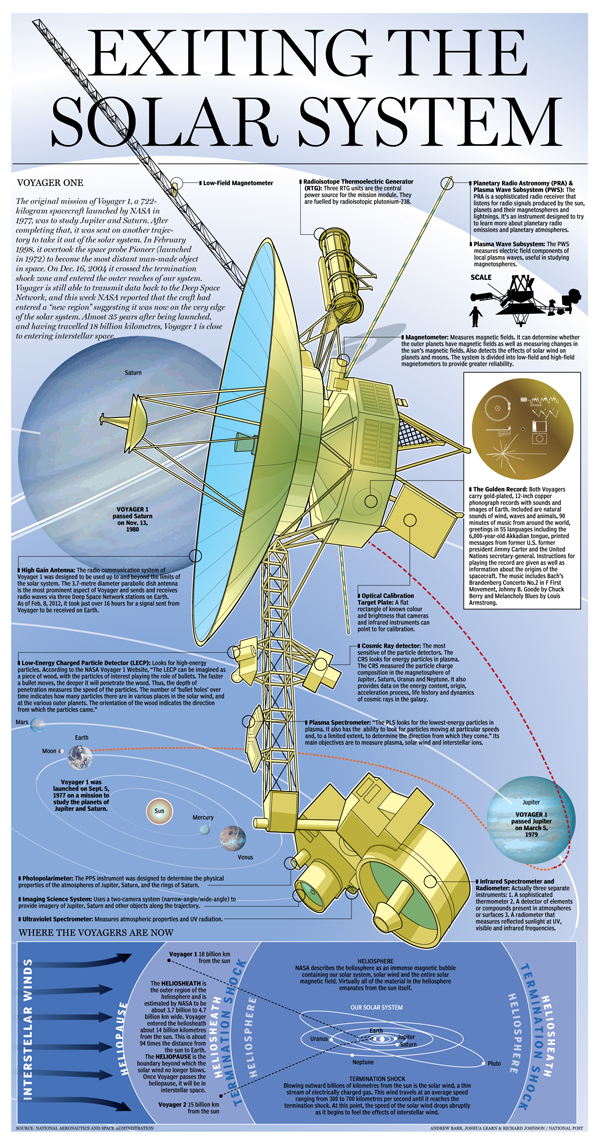
Credit for the piece goes to Joshua Rapp Learn, Andrew Barr, and Richard Johnson.
It appears as if the Greeks, who voted in parliamentary elections for the second time in as many months, have narrowly voted for pro-bailout parties. But whether the pro-bailout parties can put aside their other political differences and form a coalition government remains to be seen.
Until we see that, thanks to the National Post, we can see an infographic comparison between Greece and Germany, arguably the worst and the best European economies.
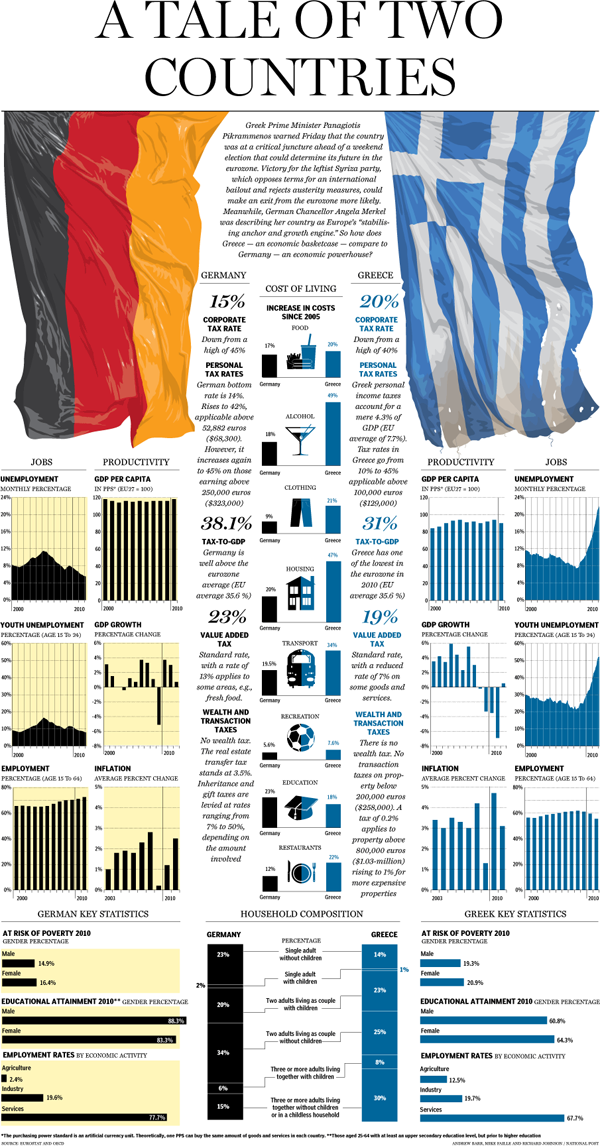
I appreciate the mirror approach, but wonder if the comparisons might not have been clearer if measured directly? Or what would have happened without the mirror approach and compared the two countries in single but slightly larger charts? Regardless, one can easily see that Greece has some serious problems.
Credit for the piece goes to Andrew Barr, Mike Faille, and Richard Johnson.
Canada is spending more than ever on its military. The question is, to what end? Canada shares a land border with only two countries. And one of them is us…
From the National Post comes an infographic looking at the rising expenditures on defence and how it currently ranks in the world.
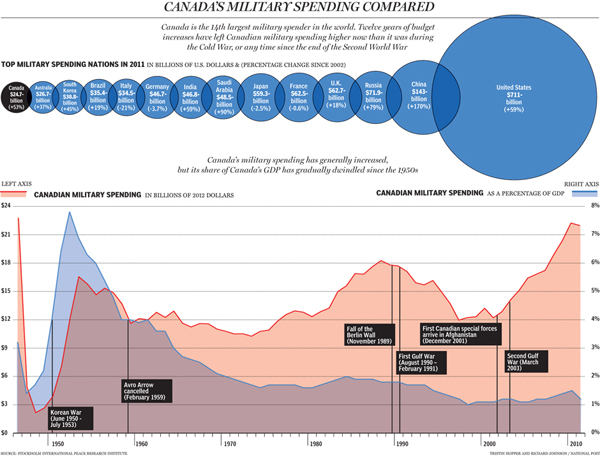
Credit for the piece goes to Tristin Hopper and Richard Johnson.
Nobody likes people cheating the unemployment system for benefits. Especially Canadians apparently. So this is a proposal to encourage the unemployed to start working.
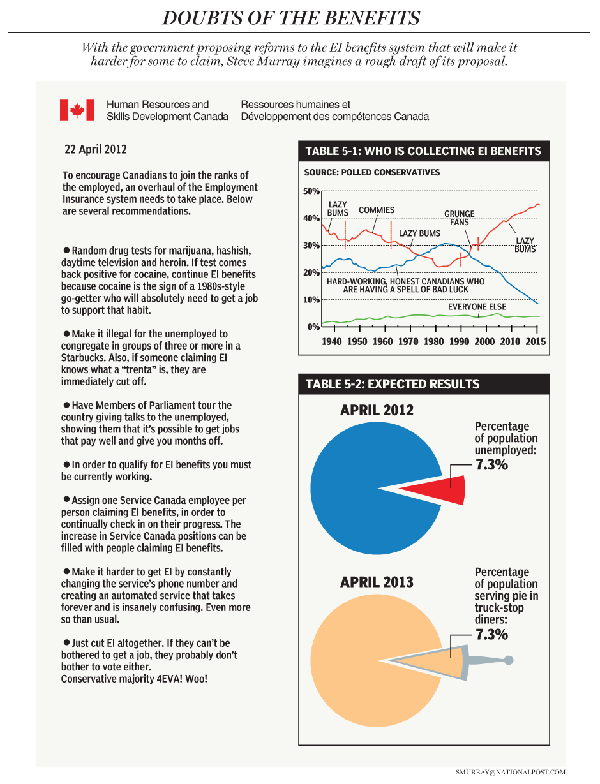
Credit for the piece goes to Steve Murray.
Subways. Home of the mole people. And in the United States an unwanted recipient of government money to build things. Along with being generally unwanted. By those who do not live in cities. Probably because of said mole people. Or something.
But in Canada, they like subways. At least enough that Toronto is building an extension to a university and from there to a suburb. But the invasion of the mole people homeland is a complex process that, fortunately, the National Post explains in an illustrative infographic, a cropping of which is below.

Credit for the piece goes to Mike Faille and Peter Kuitenbrouwer.
North Korea wanted to launch a missile, but failed miserably in doing it. Richard Johnson at the National Post created an infographic, prior to the missile’s launch, that looked at what the North Koreans wanted to do.
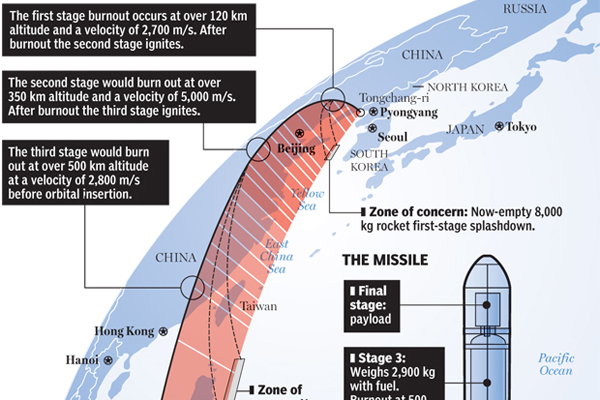
The anniversary of the RMS Titanic’s sinking led to a flurry of graphics related to the sinking, two of which I covered last week. Today’s is from the National Post and looks at the people onboard, most of whom died. Specifically, it breaks out the survivors and those who perished into their class—by berth not birth—and age. It also shows how empty most of the lifeboats were when they launched.

Credit for the piece goes to Richard Johnson.